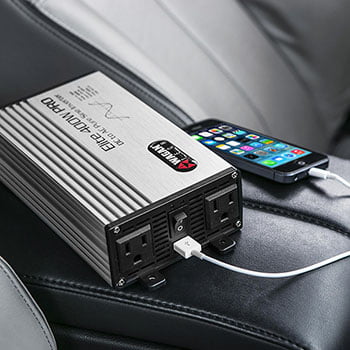Inverters are an essential part of any electronic device that converts direct current (DC) power to alternating current (AC) power. They’re efficient, cost-effective, and reliable electrical components, making them very popular in the power industry. Wherever DC to AC conversion is required, inverters are almost always used.
But what does an inverter consist of? How does it convert DC to AC? And why do inverters even need to be used in the first place? In today’s article, we take a closer look at the role of these important devices. As you’ll soon find out, inverters are used in several of our Power Systems International products, all the way from supplying backup power to converting frequencies and more.
What Are Inverters?
To make it easier to understand what inverters are, let’s first take a look at rectifiers. Rectifiers are electrical components that convert AC power into DC power. This is particularly useful for many household objects since they run on DC power, but when the power coming from the socket is AC.
These devices consist of a few simple electronic parts, but the most important element is a diode. A diode essentially only allows current to flow in one direction, and this eventually creates a DC power source.
Inverters work in the opposite way. Inverters take an AC power source and convert it into DC. There are generally two different types of inverters: mechanical inverters and electric inverters. However, electric inverters are the standard type of inverter used in industrial environments.
How Do They Work?
Converting DC into AC is not easy, and for that reason the theory behind electric inverters can very quickly become complicated, involving quasi-sine waves, true sine waves, Fourier analysis, and even surge ratings. But that doesn’t help you, does it? So we’ll try to keep things as simple as possible.
In their most basic form, inverters switch the direction of a DC power source to the load. Inverters do this rapidly, since many AC loads will run on either 50Hz or 60Hz cycles, to create the illusion of an alternating current. Switching the direction of the source 50 or 60 times within a second is obviously beyond human capabilities, so automated, electrical components need to be used.
This is where diodes and transistors come in. Three pairs of transistors are connected to a controller that sends a signal to each pair, telling them when to open and close. When the circuit is powered up, each pair of transistors allows current to pass through them for a short period of time before closing again. One pair will apply a positive DC supply to the AC load, while the next will apply a negative DC supply. The transistors open and close many times in a single cycle, and the load will receive many synchronised positive and negative supplies, resulting in an alternating current.
The amount of time each pair of transistors is open can increase or decrease the frequency wavelength of current supplied to the load.
This is a very simple, high-level explanation of how inverters convert DC to AC. There are many more intricate steps in the process that make the conversion possible, but it’s unlikely that you need to learn about these complex electrical processes.
Why Does DC Need to be Converted to AC?
So why all the fuss? Why bother with such a complicated procedure when you could just keep the power source as DC?
Interestingly, inverters are set to become even more popular in the industry. These complicated devices are becoming more and more capable as their size decreases, allowing them to work in a number of different environments.
One of their most desirable features is converting DC power stored in a battery into AC power used in industry. If a power plant, hospital, or even an IT headquarters should lose power, they will always have a backup power source they can rely on. Since this is normally achieved with batteries (that only store DC power), the value of inverters is priceless.
What Are Inverters Used For?
At Power Systems International, inverters are used on a number of our best-selling products. Since we work with clients in aviation, marine, and industrial environments, we often design products for high-dependency sites that need a reliable backup power source.
Inverters are used on our frequency converters, uninterruptible power supplies (UPS), and even our variable speed drives (VSDs) to convert DC to AC seamlessly. If you’d like to find out more about how we use inverters or how our products can be used on your project, then please don’t hesitate to get in touch with our team today.


